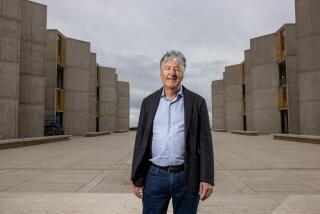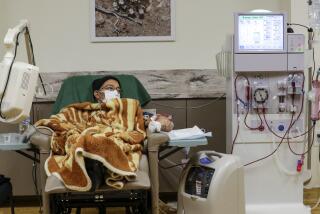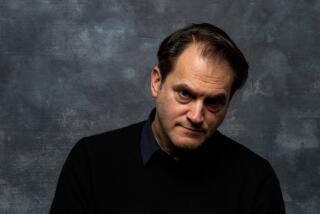For Salick Centers, Treating Cancer Is a 24-Hour Battle
To Dr. Bernard Salick, founder and chairman of fast-growing Salick Health Care Inc. in Beverly Hills, persistence is the key.
It took perseverance to start a new kind of medical service--cancer care centers that provide diagnosis and treatment on a 24-hour basis. But Salick Health Care, which affiliates its centers with existing hospitals, now operates four around-the-clock facilities--one at the Cedars-Sinai Medical Center in Los Angeles and three in Florida--and has plans for more.
The cancer care operations--outpatient kidney dialysis is the company’s other line of medical service--have bolstered Salick Health Care. Since 1985, when the company opened its first cancer center, profits have more than doubled, to $3.3 million on revenue of $25.7 million. Last year, about 30% of Salick’s revenue was produced by the cancer care centers; now they generate nearly 55%, the company says.
Salick, which already has agreements to open new centers at two East Coast university hospitals, is negotiating deals to open at least eight other centers. In addition, it agreed earlier this month to develop outpatient cancer treatment facilities for Premier Hospitals Alliance Inc., a for-profit cooperative owned by 40 hospitals. Premier, based in Westchester, Ill., has agreed to recommend Salick to its members and help the firm negotiate deals with alliance institutions.
More and more hospitals are likely to seek convenient, specialized operations like Salick’s centers because it can give them a competitive edge, according to Larry Selwitz, an analyst at Cruttenden & Co. in Newport Beach.
“People who run hospitals are asking themselves, ‘What can we do to make the public view us more favorably?’ ” Selwitz said. “Hospitals are even advertising more. A cancer treatment center is something you can point to. . . . It also helps with fund raising.”
Selwitz said Salick has very promising prospects if it does not expand too rapidly and grow beyond the company’s management capacities, a mistake that some health-care companies have made.
“Their financial situation is extremely strong,” said Theodore Levy, an analyst with Sage, Rutty & Co. in Rochester, N.Y. “I see this company . . . filling a gap in medical treatment. A lot of hospitals are clamoring for something like this.”
Hospitals, said Levy, need more outpatient operations because it is less costly than keeping patients in hospital beds, an important consideration in an industry that has been scrambling to cut operating costs.
Much Investment Income
The cost cutting has been prompted by the federal government’s 1983 Medicare reforms. Under the reforms, which are designed to stop the rapid rise in Medicare costs, the government established a payment system that predetermines the amount it will pay for certain services. Hospitals, which had been submitting bills based simply on their rising costs, were forced to tighten their belts to cope with the new fee system.
Some analysts say Salick centers are attractive to hospital executives because the firm, not the hospitals, accepts the financial risks. Salick, they note, finances the construction of the center and provides the attendant equipment. Salick hires and pays the nurses and technicians. The doctors, who are self-employed, are offered space.
Much of Salick’s initial financing came from investors who bought the company’s $18-million stock offering in 1985 and $30-million bond issue in 1986, deals that were underwritten by the investment firms Drexel Burnham Lambert and Swergold, Chefitz & Sinsabaugh. Bernard Salick still holds about 45% of the firm’s stock.
The company’s early operations were also boosted by the stock and bond sales. About 30% of Salick’s pretax profits in 1987 and 1986 came from investment income.
The company’s expansion is being marshaled by its founder, a kidney specialist who initially had difficulty selling the concept of 24-hour cancer care to hospital executives and investment bankers. In fact, Salick said he might not have attempted to develop a chain of 24-hour facilities if not for the needs of a young girl.
Salick’s daughter, Elizabeth, was 6 years old when she complained of leg pain the night of June 28, 1983. Salick suspected a sprain because Elizabeth sometimes suffered minor injuries during gymnastic exercises. As a precaution, he arranged to have his daughter undergo X-rays the next day. On that day, Salick said he was given the bad news by a sad and solemn-sounding radiologist: Elizabeth Salick had bone cancer in one leg.
When doctors recommended amputation of the leg, Salick and his wife authorized the operation. Doctors also prescribed chemotherapy, a treatment that kills cancerous cells. However, because chemotherapy also kills some non-cancerous cells--including the white blood cells that attack the microscopic causes of illness--Elizabeth had to be given periodic blood tests to ensure that her white blood cell count was sufficient.
Elizabeth needed a blood test because she had developed a fever in the wake of chemotherapy treatment. It was during the first hospital visit that Bernard Salick concluded there was a gap in the cancer treatment system.
“I realized there was a problem when she was in the hospital for five hours,” Salick said, recalling a long wait in the emergency room. “An emergency room is designed to deal with whoever checks in first and for people with the greatest emergency--survivors of car accidents and heart attack victims. . . . The nurse had 15 (other) patients.”
Similar to Dialysis
Salick’s search for the best care for Elizabeth led to New York Memorial Sloan-Kettering Hospital, where she was able to get prompt treatment at an outpatient cancer treatment center. The facility, then managed by Dr. Gerald Rosen, is open during regular business hours.
“It was after our visit with Dr. Rosen that I realized that the treatment of cancer was similar to dialysis because patients need constant access to medical facilities,” Salick recalled. “That’s when I got the idea for creating a center that would be open 24 hours--a facility that would have everything a patient needed under one roof.”
The concept seemed financially sound to Salick, who considered the rate of cancer--one out of three Americans will develop the disease in their lifetime--and the constant needs of patients. Cancer can be removed through treatment or surgery--Elizabeth Salick is now free of the disease--but Salick said he also considered the fact that former cancer patients need convenient facilities for periodic examination.
Salick asked Rosen to join Salick Health Care to help develop and manage around-the-clock facilities that would offer diagnosis, pharmaceutical services and the full range of cancer-related treatment--surgery, radiation therapy and chemotherapy, for example--as well as financial and nutritional counseling.
“He thought I was just blowing hot air,” said Salick, who persuaded Rosen to join him after providing a tour of his outpatient dialysis operations.
Salick said he found it easier to sell hospitals and doctors on the concept of 24-hour facilities after attracting Rosen to the business.
Invests in Marketing
“No one had ever done what we were planning to do,” Salick said. “Doctors are afraid to try something new, and hospitals are afraid to try something new. We had to prove we had the expertise. We did that by hiring a world-renowned cancer treatment specialist.”
The company also invests time and money in marketing and promoting its services. Salick retains a public relations firm, and analysts say Salick executives are eager to discuss developments.
Some cancer experts still have reservations about the concept of the centers. For example, Dr. Bruce Chabner, director of the cancer treatment devision at the National Cancer Institute in Bethesda, Md., is impressed with Rosen’s credentials but said he is not convinced that there is a great demand for around-the-clock facilities. The institute, which provides cancer treatment at a 500-bed hospital, conducts research on oncology, the branch of medicine dealing with tumors. The government agency also finances oncological research at designated cancer centers around the country.
“Some of the people associated with it (Salick Health) are well recognized,” Chabner said. “I think it’s nice that they offer the whole package (of services), but so do other cancer centers. I’m not so sure they (Salick centers) are more convenient than other cancer centers.”
Cedars-Sinai was the first hospital to accept the concept. Salick opened an interim facility inside the Los Angeles hospital in 1985 and, with some of the proceeds of a public stock offering, financed the construction of an adjoining building. The cancer care operation moved into the colorful and architecturally distinctive new building last January.
“Before we had 24-hour service, a cancer patient would have to come into the emergency room,” said Paula Correia, a spokeswoman for Cedars-Sinai. “We want to position ourselves as a major center for treating cancer. It’s a little early to determine what this (the Salick center) does for us financially, but we’re doing it because we want to be on the leading edge. . . . We now have a more humanistic way of treating cancer patients.”
Success Story
Patients treated at the centers seem pleased with the care, according to executives at hospitals that have Salick centers. Nationally, about half of all patients that are treated become cancer-free, according to the National Cancer Institute, and Salick centers have their own medical success stories.
For example, William Magee, a 23-year-old La Crescenta man, is now free of the bone cancer that he carried last year. Magee began to receive treatment at the Cedars-Sinai Salick center in December, 1986, and continues to report to the center for periodic examinations.
“You have the freedom to come in and go,” Magee said. “One of the most important things for a cancer patient is to get answers, and the nurses there (at Salick) give them to you. The nurses were my support group.”
In all, 40 of the 90 staff members at the Cedars-Sinai Salick center are nurses. Of the 500 Salick employees nationwide, about half are medical professionals such as nurses or technicians. Doctors practice at Salick centers, but they are self-employed and are not on the Salick payroll.
Affiliate hospitals bill Salick patients directly and--in return for the institution’s grounds, the affiliation and certain services--the hospitals receive up to 15% of Salick’s pretax earnings.
It’s been a profitable arrangement for Salick, which expects to post net income of $4.3 million in the current fiscal year, an increase of $1 million. Industry analysts tend to agree with that projection, and most are impressed.
More to Read
Inside the business of entertainment
The Wide Shot brings you news, analysis and insights on everything from streaming wars to production — and what it all means for the future.
You may occasionally receive promotional content from the Los Angeles Times.










